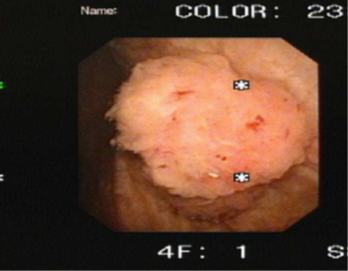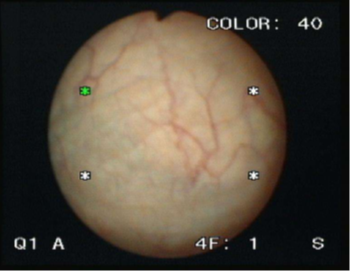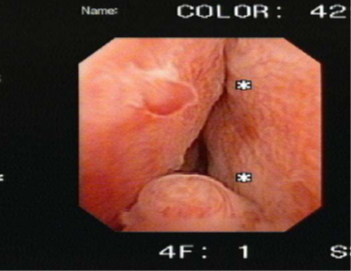What is Flexible Cystoscopy?
Cystoscopy is a procedure where a flexible tube is passed down the urethra to examine the bladder and the urethra. The tube is as thick as a drinking straw, and has a small light bulb attached to the end of it.
The cystoscope (tube) is flexible enough to move through the curves of the urethra. Hence, you do not need general anaesthesia for a cystoscopy.
During the procedure, biopsies (samples) taken from the lining of the bladder will not cause major discomfort.
Why do You Need a Flexible Cystoscopy?
A flexible cystoscopy is a quick and easy way to identify the cause of problems such as:
- Blood in your urine (Haematuria)
- Frequent urinary tract infections
- Difficulty or pain when you urinate
- Urine Incontinence (Inability to control when you urinate)

Cystoscopic view of a bladder tumour
What can You Expect for the Procedure?
Before the Procedure
- You can eat and drink as per normal before your appointment.
- Report to TTSH Clinic 2B Endoscopy Suite at your allocated time slot. The appointment (including the procedure) will last two to three hours.
- You should try to pass urine before the procedure. This will allow your doctor to have a clearer examination of your bladder and urethra.
- You should continue to take your usual medications unless otherwise specified by your doctor.
During the Procedure
- The procedure will take 10 to 15 minutes.
- Local anaesthetic jelly will be inserted into the urethra to numb the area.
- The doctor will gently insert the tip of the cystoscope into the urethra. You will experience some slight discomfort during the procedure and a tingling sensation when the tip of the scope reaches the entrance to the bladder.
- At the end of the procedure, it is normal to feel as if you need to pass urine.

Cystoscopic view of normal bladder lining
After the Procedure
- Your doctor will explain the findings after the cystoscopy.
- You should drink 2-3 litres of fluid per day to keep the urine clear and to reduce any discomfort.
What are the Potential Side Effects of the Procedure?
A cystoscopy is generally safe, but possible side effects may include the following:
- Discomfort. You may feel a mild burning sensation when you urinate, but this should only last for one or two days.
- Urinary Tract Infection (UTI). This condition is rare and only occurs in less than 3% of cases. You can reduce the risk of a UTI by drinking plenty of water after the procedure. Prophylactic antibiotics are generally
not necessary. - Bleeding. You may experience a small amount of bleeding, especially if a biopsy (sample) has been taken.

Cystoscopic view of an enlarged prostate gland (males only)
Inform Your Doctor Immediately if You Have:
- Persistent fever which is higher than 38oC and chills
- Excessive blood or clots in your urine or stools
- Difficulty or inability to urinate
Disclaimer:
The instructions in this pamphlet are non-exhaustive. In specific cases, you may receive different or additional instructions from your doctor.
You are advised to follow any specific written or oral instructions given to you by your healthcare team.
Please clarify any queries with your healthcare team when you are in doubt.
